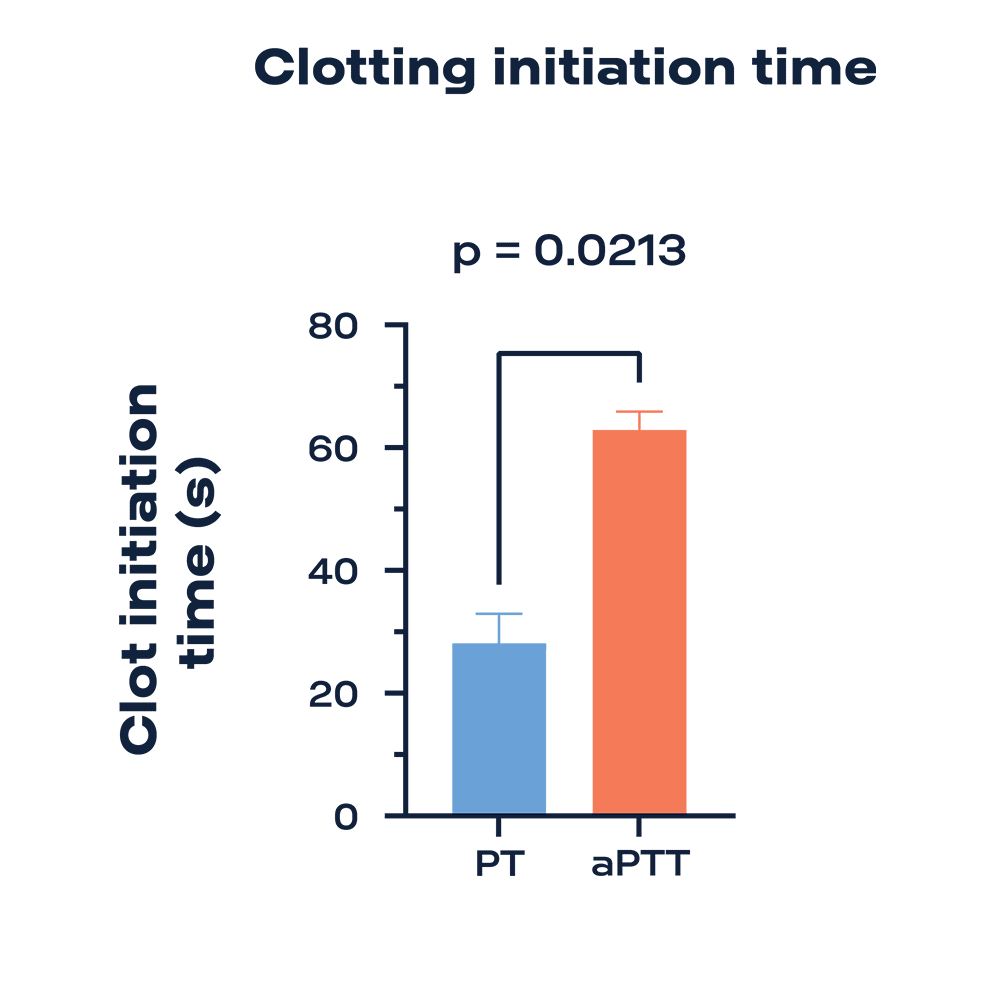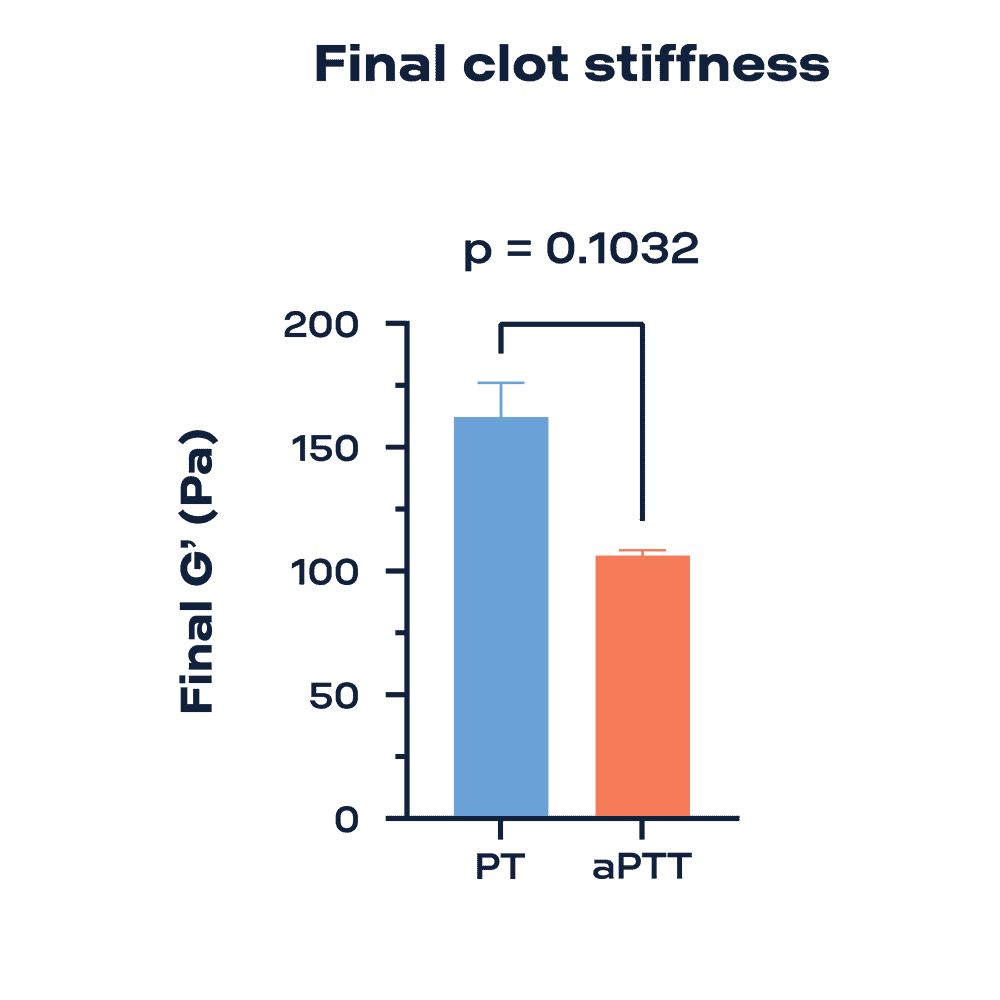Application Note | ElastoSens™ Bio
McGill University
How to measure the coagulation kinetics of blood plasma using ElastoSens™ Bio?
by Dr. Dimitria Camasão
Senior Application Specialist, Rheolution Inc.
NOTICE
This study was a joint collaboration between Rheolution Inc. (QC, Canada) and PR. Showan Nazhat’s group (Department of Mining and Materials Engineering, McGill University, QC, Canada).
SUMMARY
- Clotting tests, such as prothrombin time (PT) and activated partial thromboplastin time (aPTT), are frequently used in clinics and research to identify coagulation disorders and to guide coagulant and anticoagulant drug development.
- ElastoSens™ Bio successfully measured the viscoelastic properties of coagulating animal plasma when mixed with PT and aPTT reagents.
- The activation of the extrinsic pathway (with PT) led to faster plasma coagulation and to a stiffer clot when compared with the activation of the intrinsic pathway (with aPTT).
INTRODUCTION
The human body has a natural mechanism to stop bleeding after an injury. Platelets migrate to the site of injury and start to form a soft blood clot. This activates other clotting factors in the bloodstream triggering a chain reaction to form a harder blood clot that will stay firmly in place.
Coagulation disorders can result in two opposite conditions: the blood clots easily even without an injury or takes too long to clot after an injury. The first condition may lead to abnormal clots flowing freely within blood vessels that could potentially block the blood flow and cause serious complications such as heart attack and stroke. The second condition can lead to serious blood loss after an injury or surgery.
Coagulation disorders of a patient are detected with blood or plasma clotting tests such as prothrombin time (PT) and activated partial thromboplastin time (aPTT). The results of this test are compared to reference values to help determine the coagulation state of the patient and guide an optimal treatment. In research, these tests can also be used for the development of coagulant and anticoagulant drugs and technologies.
In this application note, the ElastoSens™ Bio was used to investigate the coagulation kinetics of blood plasma mixed with commercial PT and aPTT reagents in terms of viscoelastic properties.
MATERIALS AND METHODS
Pacific Hemostasis® Thromboplastin-DS and Pacific Hemostasis® APTT-XL (Fisher Diagnostics®, Thermo Fisher Scientific Inc., ON, Canada) were used to induce the extrinsic and the intrinsic coagulation pathway of calf plasma (Cedarlane, ON, Canada), respectively. Sample preparation was performed according to the manufacturer guidelines. Briefly, plasma was thawed at 37 °C and reagents were prewarmed at the same temperature. Plasma and reagents were mixed in the ratio of 1:2 (2.5 mL of plasma and 5.0 mL of reagents), transferred into the sample holder of the ElastoSens™ Bio (Rheolution Inc., QC, Canada), and the test in the soft mode was immediately started at 37 °C for 300 s.
The shear storage modulus (G’) as function of time of each sample was analyzed for the determination of the following descriptors:
- Clotting initiation time: time in which G’ reached 15 Pa (considered as the transition point from liquid plasma to soft gel clot)
- Max rate of clotting: maximum value found for the rate of stiffening (in Pa/s)
- Final clot stiffness: average G’ at the end of the test (calculated between 250 s and 300 s)
Average results are expressed as mean ± standard deviation (n = 2). Statistical analysis was performed using GraphPad Prism version 9 (GraphPad Prism Software, CA, USA). Unpaired t-test with Welch’s correction was applied.
RESULTS AND DISCUSSION
Figure 1 shows the shear storage modulus (G’) of animal plasma with PT (blue) and aPTT (orange) reagents as function of time. For both reagents, G’ started close to 0 indicating that the sample was still liquid in the beginning of the test. The G’ then gradually increased as a function of time. PT and aPTT trigger the extrinsic and the intrinsic pathway of coagulation, respectively. The extrinsic pathway is shorter, so it is expected that the coagulation happens faster when compared to the intrinsic pathway once activated separately in vitro [1]. Indeed, G’ began to increase before (i.e. clot started to form faster) for the plasma mixed with the PT reagent when compared to the aPTT reagent. All samples formed a clot by the end of the test (Figure 2).


Figure 1: Shear storage modulus (G’) as a function of time of animal plasma with PT (blue) and aPTT (orange) reagents.

Figure 2: Plasma clot at the end of the test.
Figure 3 shows that clotting initiation time was 28.2 ± 4.8 seconds for the PT against 62.9 ± 3.0 seconds for the aPTT (p<0.05). The maximum rate of clot formation was higher for the PT (4.3 ± 0.4 Pa/s) when compared to the aPTT (2.3 ± 0.1 Pa/s). The final clot was also different in terms of final stiffness. Average G’ in the plateau region of the curves were 162.3 ± 13.8 Pa for the PT reagent and 106.3 ± 2.2 Pa for the aPTT reagent. The clot stiffness is related to the components initially present in the sample and their interactions. Higher stiffness can suggest that a higher amount and/or stronger links among the plasma components (such as fibrinogen, thrombin, and clotting factors) happened.



Figure 3: Clotting initiation time, maximum rate of clot formation, and final clot stiffness of calf plasma with PT (blue) and aPTT (orange) reagents.
CONCLUSIONS
ElastoSens™ Bio successfully measured the viscoelastic properties of coagulating animal plasma when mixed with PT and aPTT reagents. Animal plasma started to coagulate faster, had a higher rate of formation, and resulted in a stiffer clot when mixed with the PT reagent when compared to the aPTT reagent.
PERSPECTIVES
- ElastoSens™ Bio is able to capture subtle changes in very soft samples such as coagulating plasma.
- The stiffness of the formed plasma clot can also provide valuable information about the extrinsic and intrinsic coagulation pathways as it is directly related to the components present in the sample and their interactions.
- ElastoSens™ Bio can be used in preclinical studies to investigate the effect of coagulant and anticoagulant drugs on plasma.
- The stability of the formed plasma clots can be monitored over time with the same sample using the ElastoSens™ Bio.
ElastoSens™ Bio
INTRODUCTION
The human body has a natural mechanism to stop bleeding after an injury. Platelets migrate to the site of injury and start to form a soft blood clot. This activates other clotting factors in the bloodstream triggering a chain reaction to form a harder blood clot that will stay firmly in place.
Coagulation disorders can result in two opposite conditions: the blood clots easily even without an injury or takes too long to clot after an injury. The first condition may lead to abnormal clots flowing freely within blood vessels that could potentially block the blood flow and cause serious complications such as heart attack and stroke. The second condition can lead to serious blood loss after an injury or surgery.
Coagulation disorders of a patient are detected with blood or plasma clotting tests such as prothrombin time (PT) and activated partial thromboplastin time (aPTT). The results of this test are compared to reference values to help determine the coagulation state of the patient and guide an optimal treatment. In research, these tests can also be used for the development of coagulant and anticoagulant drugs and technologies.
In this application note, the ElastoSens™ Bio was used to investigate the coagulation kinetics of blood plasma mixed with commercial PT and aPTT reagents in terms of viscoelastic properties.
MATERIALS AND METHODS
- Clotting initiation time: time in which G’ reached 15 Pa (considered as the transition point from liquid plasma to soft gel clot)
- Max rate of clotting: maximum value found for the rate of stiffening (in Pa/s)
- Final clot stiffness: average G’ at the end of the test (calculated between 250 s and 300 s)
RESULTS AND DISCUSSION
Figure 1 shows the shear storage modulus (G’) of animal plasma with PT (blue) and aPTT (orange) reagents as function of time. For both reagents, G’ started close to 0 indicating that the sample was still liquid in the beginning of the test. The G’ then gradually increased as a function of time. PT and aPTT trigger the extrinsic and the intrinsic pathway of coagulation, respectively. The extrinsic pathway is shorter, so it is expected that the coagulation happens faster when compared to the intrinsic pathway once activated separately in vitro [1]. Indeed, G’ began to increase before (i.e. clot started to form faster) for the plasma mixed with the PT reagent when compared to the aPTT reagent. All samples formed a clot by the end of the test (Figure 2).


Figure 1: Shear storage modulus (G’) as a function of time of animal plasma with PT (blue) and aPTT (orange) reagents.

Figure 2: Plasma clot at the end of the test.
Figure 3 shows that clotting initiation time was 28.2 ± 4.8 seconds for the PT against 62.9 ± 3.0 seconds for the aPTT (p<0.05). The maximum rate of clot formation was higher for the PT (4.3 ± 0.4 Pa/s) when compared to the aPTT (2.3 ± 0.1 Pa/s). The final clot was also different in terms of final stiffness. Average G’ in the plateau region of the curves were 162.3 ± 13.8 Pa for the PT reagent and 106.3 ± 2.2 Pa for the aPTT reagent. The clot stiffness is related to the components initially present in the sample and their interactions. Higher stiffness can suggest that a higher amount and/or stronger links among the plasma components (such as fibrinogen, thrombin, and clotting factors) happened.



Figure 3: Clotting initiation time, maximum rate of clot formation, and final clot stiffness of calf plasma with PT (blue) and aPTT (orange) reagents.
CONCLUSIONS
ElastoSens™ Bio successfully measured the viscoelastic properties of coagulating animal plasma when mixed with PT and aPTT reagents. Animal plasma started to coagulate faster, had a higher rate of formation, and resulted in a stiffer clot when mixed with the PT reagent when compared to the aPTT reagent.
PERSPECTIVES
- ElastoSens™ Bio is able to capture subtle changes in very soft samples such as coagulating plasma.
- The stiffness of the formed plasma clot can also provide valuable information about the extrinsic and intrinsic coagulation pathways as it is directly related to the components present in the sample and their interactions.
- ElastoSens™ Bio can be used in preclinical studies to investigate the effect of coagulant and anticoagulant drugs on plasma.
- The stability of the formed plasma clots can be monitored over time with the same sample using the ElastoSens™ Bio.
ElastoSens™ Bio
Related Posts
The ElastoSens™ Bio was used to analyze the effects of hemostatic agents (HAs) on blood coagulation. The technology identified HAs that can alter clotting independently of the body's natural processes. These findings can optimize current HAs and aid in developing new ones.
Hemostatic agents (HAs) can be absorbable, biological, or synthetic. Absorbable HAs, like gelatin or oxidized cellulose, speed up clotting and are naturally absorbed by the body. Biological HAs include thrombin, fibrinogen, and platelets which are key to blood clotting. Synthetic HAs, such as polyethylene glycol, form strong sealant matrices. The choice of HA depends on the type of bleeding, tissue interaction, and patient's coagulation profile. Instruments like the ElastoSens™ Bio provide valuable data on HA efficacy by measuring blood absorption and coagulation kinetics.
Scientists from Dalhousie University, led by Dr. Mark Joseph Filiaggi, investigated the sodium polyphosphate (NaPP) polymer as a potential hemostatic agent. They tested six formulations of the biomaterial, with varying degrees of polymerization and types of divalent cations. The hemostatic potential of these formulations was evaluated using various blood clotting assays. The biomaterial was mixed with coagulation reagents and recalcified blood or plasma in a tube, which was then shaken to visually assess blood or plasma flow. The clotting time was noted as the time required to achieve no flow. Surgifoam®, a commercial hemostatic agent, was used as a control.
In a recent study published in the Critical Care Medicine Journal, researchers from Western Michigan University, the University of Texas, and healthcare-related offices across the United States investigated the relationship between COVID-19 and blood coagulation disorders. They found that analyzing the viscoelastic changes in coagulating blood can provide personalized information on a patient's coagulation state, offering valuable insights for treatment optimization. The study highlights the importance of a personalized patient-oriented approach due to the diverse clinical profiles observed in COVID-19 cases.
The viscoelastic properties of coagulating blood can be correlated with several diseases and genetic conditions that affect the natural blood coagulation process including bleeding disorders, hemophilia, rare factor deficiencies, von Willebrand disease and platelet function disorders. Therefore, the evaluation of blood clot properties can be valuable for the study, diagnosis and eventually treatment of these diseases.
Hemostatic agents (HA, e.g. powders, gauzes, adhesives and sealants) have been used for decades to control bleeding. The demand for these agents is growing due to two major trends in surgical practice: the expansion of minimally invasive surgery and complex reconstructive procedures that are more limited in their capacity to obtain hemostasis.








